By Chris ParryAtlantic Publishing
Part 1 of 3: Establishing House Drink Recipes
A bartender makes a good drink with originality, panache, speed and skill - but a great drink starts with the boss. You determine the drink menu, you determine the recipes to be used and you set the price and make the rules. Your staff just follows your lead. In many bars, it's left to individual members of staff to know the "standard" formulas for cocktails and mixed drinks. Everyone is supposed to know that a Tequila Sunrise has one shot of tequila, right? Or is it two? Maybe it's a shot and a half... Profits are too hard won to just throw away alcohol when your staff crosses their wires about your drink recipes. Some easy steps to ensuring standardization of your house recipes include:
- Recipe lists. Make sure when you take on new staff they receive detailed recipe lists to take home and look over before they start their first shift. It doesn't cost you a lot to photocopy a few pages of text and give them to your staff, so make sure there's no excuse for them not to know as much as they can before they start mixing on your dime.
- Recipes on display. Ensure that there are either laminated index cards or recipes listed behind the bar at all times so that any member of staff - even emergency fill-ins and temps - can see exactly what is needed to prepare each drink - no more, no less. Below is an example of a recipe card and the information it should contain:
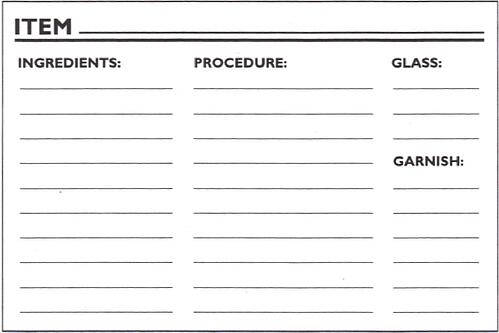
- Cocktail menus. When you leave cocktail menus on tables, make sure that each one shows exactly what is in the drink - not just the ingredients, but the ounce amounts of each. This will not only serve as a more informative drink menu to your customers, but will also allow them to more accurately measure what they've consumed over the course of the night.
- Premium ingredients. If you use premium or middle-shelf ingredients in your cocktails, make sure that your cocktail menus make a point of that fact by showing the brands used. There's no point in hiding the fact that your base spirits and liqueurs are of a higher quality than those of your competition, especially because your liquor distributor might chip in for some of the cost of printing if they're being marketed in your literature in this fashion.
- Accuracy. Make certain that the cocktail and mixed-drink recipes give a clear indication of what glass is to be used, what garnish should be used, for how long and on what setting any blended drink should be blended and what brands of alcohol should be used for their creation. If you leave anything out, you can bet someone will get it wrong - and with alarming regularity.
- Bartending recipe computer programs. For example, Interworlds Software's "BarBack for Windows" can tell your staff how to create a drink even if a customer asks for something ridiculously obscure. BarBack includes over 10,000 different drink recipes, as well as information on glassware, ingredients, mixing methods and garnishes. Rather than taking away from the skills of your staff, insightful programs such as these actually complement their skills to ensure your customers get exactly what they want in the quickest possible time. BarBack can be downloaded at www.barback.com .
This article is an excerpt from the Food Service Professional Guide to Bar & Beverage Operation, authored by Chris Parry, published by Atlantic Publishing Company. This excerpt has been reprinted with permission of the publisher. To purchase this book go to:
Atlantic Publishing Company
Amazon.com
Topics:
inventory managers,
Bar inventory,
bar inventory levels,
Bar staff,
bar profitability,
alcohol,
NightClub Management,
bar business,
Bar Management,
bar control,
Drink Recipes,
controling costs,
liquor products
By Chris ParryAtlantic Publishing
Part 2 of 2: Protecting Your Profits
Your profit margin, like that of any business, is fragile at best. You can sit down with a calculator and try to calculate the exact percentage you'd like to see on each drink. But in practice, a little splash too much here and there can see you falling perilously close to a loss. Follow these rules and you'll be that much more likely to see your bottom line behind the bar match that of your balance sheet estimations.
- Watch what your staff pours. Regularly measure what they consider an ounce. If just one bartender overpours 40 shots a night by 25 percent, you've given away ten drinks for nothing. This kind of waste can get very expensive, especially if you have a large bar staff and they're all pouring more than 40 drinks per night.
- Have your staff keep all the liquor in the glass. Many staff members get lazy as the night wears on, and inevitably they'll start taking shortcuts. One shortcut many take is to line up three or four glasses and pour one after the other in a straight line without raising the head of the bottle. While this may save them a second or two, it also pours a lot of your product directly onto the bar surface, not to mention down the sides of the glasses that your customers are about to put in their hands. It also means your customers are far less likely to get what they've paid for. Don't let it happen.
- There are alternatives to free-pouring. While free-pouring certainly is more stylish and perhaps faster than measured pouring, it is also definitely far from accurate. As bar staff generally tend to err on the side of caution, they usually pour too much rather than too little. Control-pour spouts, such as Posi-Pour spouts, are a little more expensive than the usual free-pour, but they give a far more accurate pour without the need for clunky overhead systems or sophisticated electronics - and at much the same speed as free-pourers.
- Liquor control system. If you really want to keep an eye on your outgoings, a liquor inventory control system may be your answer. The price of setting these systems up, and maintaining them, can be significant. Then again, you get what you pay for.
This article is an excerpt from the Food Service Professional Guide to Bar & Beverage Operation, authored by Chris Parry, published by Atlantic Publishing Company. This excerpt has been reprinted with permission of the publisher. To purchase this book go to:
Atlantic Publishing Company
Amazon.com
Topics:
Bar inventory,
managing liquor inventory cost,
bar business,
profit,
Bar Management,
alcohol cost,
bar control,
controling costs
By Douglas R. BrownAtlantic Publishing
Part 2: Perpetual Inventory
The perpetual inventory is a check on the daily usage of your main entree items from the freezers and walk-ins. This is for tracking expensive items, such as meat, seafood, chicken, cans of caviar, etc. When completed, the perpetual inventory will ensure that no bulk products have been pilfered from the freezer or walk- ins. Computer software programs and some POS systems will track this information for you. The following is an example of a Perpetual Order Form:

- List all the food items that are listed on the Sign-out Sheet and Yield Form. In the "Size" column, list the unit size in which the item is packaged. The contents of most cases of food are packed in units such as 5-pound boxes or 2-pound bags. Meat is usually packed by the number of pieces in a case and the case's weight. The size listed on the perpetual inventory must correspond to the size the preparation cooks are signing out of the freezer and walk-ins.
- In the "Item" column, enter the number of each item listed. For example, if shrimp is packed in 5-pound boxes and you have two 50-pound cases, there are 20 boxes. Enter 20 in the "Item" column. Each number along the top corresponds to each day of the month. At the end of each day, count all the items on hand and enter this figure on the "=" line. Compare this figure to the "Amount Ordered or Defrosted" column on the Preparation Sheet; these amounts must be the same as the total number of each item on the "-" line. If there were any deliveries, place this total on the "+" line.
- Theft. Theft can occur when someone removes a box of shrimp from the case, for example. The person then reseals the case with the other boxes to hide the gap.
- Check the invoices every day for the items delivered that are in your perpetual inventory. Ensure that all items signed off as being delivered are actually in the storage areas. Should there be a discrepancy, check with the employee that signed the invoice. The number of items you start with (20) plus the number you received in deliveries (5), minus the amount signed out by the preparation cooks (1), must equal the number on hand (24). If there is a discrepancy, you may have a thief.
- What to do if you suspect theft. Should you suspect a theft in the restaurant, record the names of all employees who worked that particular day. If thefts continue to occur, a pattern may develop among the employees who were working on all the days in question. Compute the perpetual inventory or other controls you are having a problem with at different times of the day and before and after each shift. This will pinpoint the area and shift in which the theft is occurring. Sometimes, placing a notice to all employees that you are aware of a theft problem in the restaurant will resolve the problem. Make it clear that any employee caught stealing will be terminated.
Purchasing Kickbacks and Gifts
Unfortunately, the food service industry is notorious for kickbacks. It is even more unfortunate that these kickbacks or gifts are essentially paid for by you in the form of higher prices. Here are some ideas to help keep kickbacks out of your store:
- Purchasing and receiving must be done by different employees. The person ordering should not be the same person receiving and checking the items.
- Kickback policy. Develop a general policy and list it in your employee handbook that employees cannot receive anything for free from a vendor or potential vendor.
- Change positions. People become complacent over time; move positions around.
- Check on prices of expensive items like meat and seafood yourself.
Topics:
inventory managers,
Food Costs,
food inventory,
inventory counting,
controling costs,
inventory control,
Food control
By Douglas R. BrownAtlantic Publishing
Part 5: Purchasing and Ordering--Procedures and Practices
Purchasing and Ordering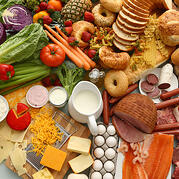
What exactly is the difference? Purchasing is setting the policy on which suppliers, brands, grades and varieties of products will be ordered. These are your standardized purchase specifications; the specifics of how items are delivered, paid for and returned. These specifications are negotiated between management and distributors. Basically, purchasing is what you order and from whom. Ordering, then, is simply the act of contacting the suppliers and notifying them of the quantity you require. This is a simpler, lower-level task. Here are the basics:
- Develop a purchasing program. Once menus have been created that meet your customers' satisfaction and your profit needs, develop a purchasing program that ensures your profit margins.
- An efficient purchasing program incorporates: Standard purchase specifications based on standardized recipes, and standardized yields and portion control that allow for accurate costs based on portions actually served.
- Keep in mind: Purchasing more than you need usually results in poor portioning, excess spoilage, waste and theft. Not buying enough can mean paying retail prices, or using a more expensive substitute.
- Purchasing procedures. These procedures should include creating written purchasing specifications for every product and selecting good, reliable purveyors. Your purchasing procedures should do three things:
- Allow you to purchase the required items at prices that meet your food cost goals.
- Maintain control over your existing inventory.
- Establish a set of procedures to be sure that you receive quality product at the best price.
- Purchasing responsibility. Either take on the purchasing yourself or assign a specific employee to do it. Make sure that this person keeps current with ever-changing food prices.
- Price checks for different vendors. Sometimes you may find that one vendor is less expensive than another for a while, and then this may shift. Keep current with competing vendors' prices.
Purchasing Specifications
By creating purchasing specifications, you can control which items you purchase and you can maintain product consistency. This information is extremely important if you have more than one person that does ordering in your operation. You need to record the following basic information:
- Purchasing specifications. They state the exact requirements for the amount and quality of items purchased. These specifications should include:
-
- Product name
- Quantity to be purchased (designated with correct unit such as pounds, can size, etc.)
- Indication of grade, if applicable
- Unit by which prices are quoted
- What the product will be used to produce
- Meats. Meats should be inspected by the USDA or
other appropriate agency. The parts or packaging
should carry a federal or state inspection stamp.
- Eggs. Eggs should have a USDA grade; frozen and
dried eggs should be pasteurized.
- Shellfish. Shellfish should be purchased from
suppliers that appear on public health service Food
and Drug Administration lists of Certified Shellfish
Shippers or on lists of state-approved sources. The
control tags must be available if live shellfish are
used.
- Introduce a record sheet. Make it readily available for all your employees. They need to be sure that they're ordering the correct items in the correct amounts. You're also more likely to attain your desired food cost by keeping these records and maintaining purchasing controls. Keeping your food cost down will help you to maximize profits from your menu prices. The following form illustrates an example of a purchasing specification form:
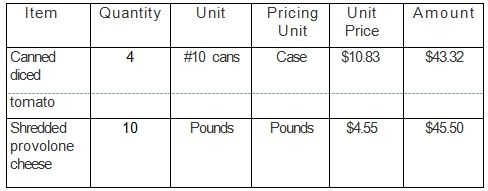
This article is an excerpt from the Food Service Professional Guide to Controlling Restaurant & Food Service Food Costs, authored by Douglas R. Brown, published by Atlantic Publishing Company. This excerpt has been reprinted with permission of the publisher. To purchase this book go to:
Atlantic Publishing Company
Amazon.com
Topics:
inventory,
Restaurant Inventory,
food inventory,
Control,
Hospitality,
inventory schedule,
inventory counting,
controling costs,
purchasing,
inventory control
By Douglas R. BrownAtlantic Publishing
Part 4: Purchasing Basics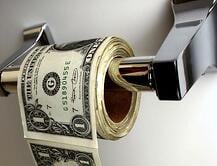
The goal of purchasing is to obtain wholesome, safe foods to meet your menu requirements. The operation must have food to serve customers when needed. The food needs to be the right quality consistent with the operation's standards and purchased at the lowest possible cost.
- Vendors and food safety. Food safety at this step is primarily the responsibility of your vendors. It's your job to choose your vendors wisely.
- Suppliers must meet federal and state health standards. They should use the HACCP system in their operations and train their employees in sanitation.
- Delivery trucks. Delivery trucks should have adequate refrigeration and freezer units, and foods should be packaged in protective, leak-proof, durable packaging. Let vendors know upfront what you expect from them. Put food-safety standards in your purchase specification agreements. Ask to see their most recent board of health sanitation reports, and tell them you will be inspecting trucks on a quarterly basis.
- Delivery schedules. Good vendors will cooperate with your inspections and should adjust their delivery schedules to avoid your busy periods so that incoming foods can be received and inspected properly.
- Your inventory system is the critical component of purchasing. Before placing an order with a supplier, you need to know what you have on hand and how much will be used. Allow for a cushion of inventory so you won't run out between deliveries. Once purchasing has been standardized, the manager simply orders from your suppliers. Records show supplier, prices, unit of purchase, product specifications, etc. This information needs to be kept on paper and preferably computerized. Purchase food items according to usage. For example, if you plan to use tomatoes by blending and mixing them with other ingredients to make a sauce, purchase broken tomatoes as opposed to whole tomatoes. However, if you intend to use tomatoes to decorate a dinner plate or as a topping, opt for high-quality produce, such as baby plum vine-grown tomatoes.
This article is an excerpt from the Food Service Professional Guide to Controlling Restaurant & Food Service Food Costs, authored by Douglas R. Brown, published by Atlantic Publishing Company. This excerpt has been reprinted with permission of the publisher. To purchase this book go to:
Atlantic Publishing Company
Amazon.com
Topics:
inventory managers,
Hotel Inventory,
Restaurant Inventory,
food inventory,
Control,
inventory schedule,
inventory counting,
controling costs,
inventory control
By Elizabeth GodsmarkAtlantic Publishing
Part 6 of 6: Valuation and Control of Inventory
Inventory Valuation Made Easy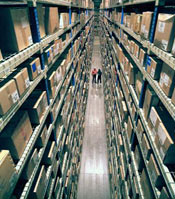
Daunted by the pros and cons of the various accounting procedures used in today's liquor, wine and beverage industry? No need. Choose the approach that best meets the requirements of your establishment. Keep it simple. The following methods are tried and tested. They are also known for their ability to control cash flow and to reduce overall costs.
- FIFO (first in, first out). This means that items in storage are valued at the level of the most-recently purchased items. FIFO helps maximize profits by extending inventory value, particularly when inflation is high. A word of warning, though: Make sure that all profits are accurately recorded and that all drinks are rotated on a strictly first-in, first-out basis.
- LIFO (last in, first out). Here, the most-recent items are recorded as the first ones used. This method is useful when prices are rising, fast. Rotate stock on a FIFO basis, but make sure that the value of the inventory reflects the oldest purchase prices. If your product valuation is keenly affected by inflation, use LIFO!
- Actual Method. With the Actual Method, the inventory is valued at actual cost. It's a bit time consuming, unless you have a computerized system - even then, the Actual Method is probably not the best choice for reducing costs.
- Last Price Method. Similar to FIFO, this is one of the most commonly used accounting procedures used in the beverage industry today. It involves using the last purchase price to extend inventory value.
- Computerized packages. Whatever your choice of method, a good-off-the-shelf package for calculating inventory values is a must.
Controlling Bar Inventory
Wastage, spillage, employee theft, oversights and inefficiency are most likely to occur in the working environment of a busy bar. Improved management of bar inventory can make a big impact on profits. Even one bottle of liquor represents a substantial profit - or loss. Introduce a few changes behind the bar. Small adjustments can make a big difference!
- Security-mark bottles. Security-mark every bottle of liquor destined for the bar when it is received into the storeroom. This identifying mark, stamp or nonremovable label (placed on the bottom or side of the bottle) proves that the bottle belongs to your operation. If you are using a computer-controlled inventory system, consider using a bar-coded label for better inventory control.
- Unauthorized sales. Empty bottles returned without a mark indicate that bar staff may possibly be serving liquor from unauthorized bottles. It is not unknown for employees to bring in their own bottles in the hope of making a fast buck!
- Control cards. All inventory requisitioned by the bar must be recorded in the perpetual inventory, usually by computer. A backup card system can act as an invaluable "double check." Don't make it complicated. All you need is a date and signature against the item.
- Bin cards. Bin cards give you extra control over high-value items. Fix small index cards (known in the trade as bin cards) to the shelves where such items are located. Keep a careful eye on the running totals.
- Backup liquor. Even on a typical busy night, one bottle of premium liquor and two to six bottles of well liquor is sufficient backup.
- Accurate records. Distinguish clearly between unopened and opened bottles when valuing inventory. Opened bottles should be measured to the nearest tenth of a bottle, using dipsticks or by weight.
Topics:
liquor inventory,
profit,
controling costs
By Elizabeth GodsmarkAtlantic Publishing
Part 6 of 7: Purchasing Specifications and Set Standards
 As a purchasing manager, it is important to set standards. Decide up front exactly what types of drinks you need to purchase and the conditions under which you will place an order. These are your purchase specifications.
As a purchasing manager, it is important to set standards. Decide up front exactly what types of drinks you need to purchase and the conditions under which you will place an order. These are your purchase specifications.
- Consult fellow members of staff. Their input is important. Of course you want them on your side, but oftentimes, it is they who know best what will sell (and what won't!).
- Purchase specifications must reflect the image of your establishment. Consider your target audience, the standards it demands and the price it is prepared to pay.
- Keep a written copy. It represents your establishment's overall purchasing standards and rules. It doesn't have to be a lengthy document; a few bulleted points will do.
- Purchase specifications should focus on the following areas: quality, quantity, consistency, reliability of vendors and availability of merchandise.
- Document your purchase specifications to vendors. Vendors need to be reminded of the standards you expect from them. Specs are also useful in the event of a dispute.
- Back up your purchase specification document with an additional product information list. Tabulate the information in chart format. Include information such as brand, country of origin, alcohol content (where applicable) and, in the case of wines, year and vintage. Use it to jog your memory when writing out purchase orders or placing orders by phone. This type of handy list can also help you spot "substitutes" when you receive the goods!
Topics:
profit,
controling costs,
purchasing,
inventory control








 As a purchasing manager, it is important to set standards. Decide up front exactly what types of drinks you need to purchase and the conditions under which you will place an order. These are your purchase specifications.
As a purchasing manager, it is important to set standards. Decide up front exactly what types of drinks you need to purchase and the conditions under which you will place an order. These are your purchase specifications.
